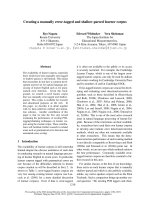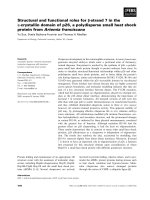Báo cáo khoa học: "If a congressist took some time to idle in the countryside near the location of this conference, he/she would encounter" pdf
Bạn đang xem bản rút gọn của tài liệu. Xem và tải ngay bản đầy đủ của tài liệu tại đây (51.07 KB, 1 trang )
Opening adress
If a congressist took some time to idle in the countryside
near the location of this conference, he/she would encounter
villages whose names sound familiar, like Saint Émilion,
Sauterne and Margaux, to name but a few. Let us take some
time to understand why they are well known. A first facet of
this reputation is their age: these names have been known to
travellers and gourmets for centuries – a reputation is not
built in one day. A second facet is the age of the product they
are known for: the age of the vineyard andtheageof the wine.
It takes time to shape a fine product. Time is probably a major
component of the quality and fame of Bordeaux wines, and
decades of refining know-how have resulted in the high stan
-
dard they are known for.
If our fellow congressist entered a vinery, he/she would
expect to see lines of wooden barrels, and dozens of skilful
workers who take care of the production bottle by bottle, with
love, because it has always been like this, and will ever be. Tra-
dition is automatically associated with time needed to produce,
and time needed to refine and polish. But it is no longer like
this. There exist barrels, there exist workers who take care of
the wine with love, but in a contemporary, high tech way.
Wine production is well known for the high tech skills which it
employs. Evolution has been very quick for the last few years.
Bordeaux is known for the number of institutes contributing to
oenology through molecular biology, for example.
As this conference demonstrates, it is the same for wood
production. Every one has in mind the centuries needed to
produce high quality oak timber, and every forest student
here has been taught that the best oaks harvested today were
planted in the time of Colbert, when overseas travels took as
much time as we will soon need to fly to the planet Mars. Tra
-
dition is often associated with wood production, especially
when quality, rather than quantity, is the goal. Once again,
the current challenge for production of quality wood is com
-
bining the time needed to establish a reputation with high
tech skills and the latest developments in molecular biology.
The outstanding quality of this conference is its success in
linking both facets of production of quality wood: wood re
-
search is deeply concerned with current (r)evolutions in mo
-
lecular biology.
Molecular biology has existed for several decades, and a
landmark was the discovery of the molecular structure of
DNA in 1953, although it had been known for longer that ge
-
netic information in chromosmomes was contained in a tiny
strand of nucleic acid. There have been several revolutions
since these pioneering times, especially since the develop
-
ment of equipment which allows routine descriptions of the
variety of words written with A, T, C and G, leading to pro
-
tein engeneering, modification of the activity of metabolic
pathways and networks, and DNA chips which visualize the
cooperation of genes. It is usual nowadays to distinguish be
-
tween metabolic networks and gene regulation networks,
both being the cornerstone of functional genomics and
proteomics. This opens the door to the possibility of under
-
standing multifactorial traits (such as growth, wood density
and resistance to stress) as ouputs of gene regulation net
-
works constantly operating within a sea of environmental sig
-
nals, and lead quantitative genetics from empirical
approaches into the framework of functional genetics.
In this context, wood quality is a new challenge. Indeed, it
takes time to make wood, as it takes time to shape a new or
-
ganism from a fertilized egg. The understanding of wood for
-
mation and quality requires the understanding of cell
differentiation and ageing processes leading to the formation
of early wood/late wood, sapwood/heartwood, etc. This re-
quires understanding the roles and regulation of chemical sig-
nals for cell communication within an organism and between
cells whose different genes are expressed, and is part of de-
velopmental biology. At the molecular level, regulating net-
works leading to wood formation are influenced by genes,
environment, and cellular communication. This is a very
“hot” research topic, which allows forest research to contrib-
ute to current frontiers of research in biology. Trees are in
-
valuable vegetative material for studying ageing when
compared with annual plants like Arabidopsis, for example.
One more word, to conclude. If our (virtual) congressist
were to idle through some villages on particular days, whose
dates are kept secret, he/she would encounter guilds of peo
-
ple, dressed in strange clothes, walking and playing music
through the villages. They are the “confréries”, who in a
lively way remind us that those fellows who produce wine be
-
long to the local community, and share the same mutual val
-
ues. As far as the cooperative facet of research is concerned,
this conference is an outstanding success as well, as its idea
originated within several European research networks.
And, last but not least, it is a pleasure for me to thank
Christophe Plomion, Christine Cahalan, Jean-Marc Frigerio,
Marie-Pierre Reviron and all students of the “Forest Genet
-
ics” unit of INRA Pierroton for the wonderful organization of
this conference, and for having given to all the participants
the possibility to share current research ideas and to enjoy the
unique taste of products of the Bordeaux area.
462
A. Franc
INRA









